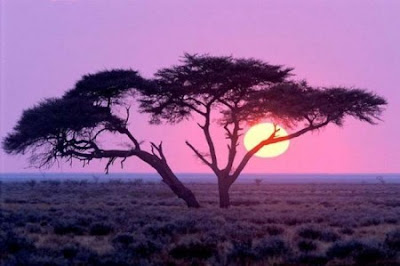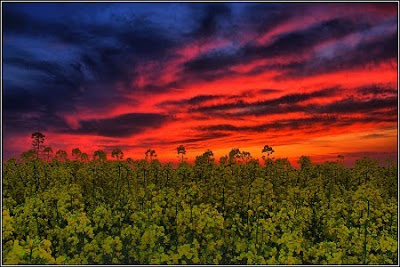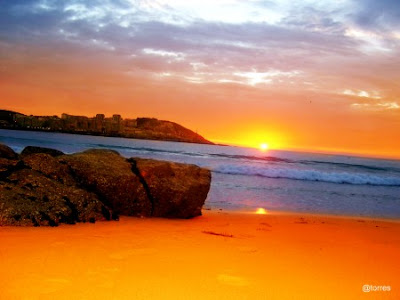Sunset is the daily disappearance of the sun below the horizon as a result of the Earth’s rotation. The atmospheric conditions created by the setting of the sun, occurring before and after it disappears below the horizon, are also commonly referred to as “sunset”.
In astronomy the time of sunset is defined as the moment the trailing edge of the sun’s disk disappears below the horizon in the west. Due to refraction of light in the atmosphere, the ray path of the setting sun is highly distorted near the horizon making the apparent astronomical sunset occur when the sun’s disk is already about one diameter below the horizon. Sunset should not be confused with dusk, which is the moment at which darkness falls, when the sun is about eighteen degrees below the horizon. The period between the astronomical sunset and dusk is called twilight.
The intense red and orange hues of the sky at sunrise and sunset are mainly caused by scattering of sunlight by dust particles, soot particles, other solid aerosols, and liquid aerosols in the Earth’s atmosphere. These enhanced red and orange colors at sunrise and sunset are mathematically explained by the Mie theory or the discrete dipole approximation. When there are no particulates in the troposphere, such as after a big rain storm, then the remaining less intense reds are explained by Rayleigh Scattering of sunlight by air molecules. Sunset colors are typically more brilliant and more intense than sunrise colors, since there are generally more particles and aerosols in the evening air than in the morning air. Nighttime air is usually cooler and less windy, which allows dust and soot particles to settle out of the atmosphere, reducing the amount of Mie Scattering at sunrise. The reduced Mie Scattering correspondingly reduces the amount of red and orange scattered light at sunrise. Sunrise color intensities can however exceed sunset’s intensities when there are nighttime fires, volcanic eruptions or emissions, or dust storms to the east of the viewer. A number of eruptions in recent times, such as those of Mount Pinatubo in 1991 and Krakatoa in 1883, have been sufficiently large to produce remarkable sunsets and sunrises all over the world.









Wednesday, November 11, 2009
Amazing Sunset Around The World
Subscribe to:
Post Comments (Atom)
Subscribe via email
Labels
3D
3D Tattoos
Abandoned
Accidentally
Adder
Adopted
ads
Advertisements
Africa
Aids
Aids Day
Airbus
Allergy
Alligators
Amanitas
Amazing
Amy Winehouse
Animal
Animals
Animals From Junk
Antarctica
Aquarium
Arachnoid
Armpit
art
Art With Knives
Arts
Asia
Atacama
Atlanta
Australia
Awesome
Awesome Toons
Baby
Barack Obama
Barbie
Barbox
Baseball Card
Bathroom
Battleship
Beach
beautiful
Beauty
Beer
Bike Ride
Bikini
Billboards
Bills
Bird
Bivalve shellfish
Bizarre
Black
Blood
Blue-Ringed Octopus
BMW
Bodypainting
Bodypainting Festival
Books
Bose
Bottles
Brazil
Breakthrough Thinking
Breasts
bridge
Brilliant
bubble gum
Bumpers
Bunny
Bus
Business
Cakes
Canada
Caricatures
Carrot
cars
cars logo
Castor Bean
Cat
Cauliflower
Caves
Celebrity
Celebs
Cell Phone
Chalk
Cheap
Cheese
Chef
Chocolate
Christmas
Church
Circles
city
Classic
Clown
Cockroach
Codeine
Coins
Computer
Concrete
Condom
Connection
Contractor
cool
Costume
Cover Art
cow
Craftsmen
crazy pic
Crazy Pics
Creations
creative
Creative Garden
Croton oil
Crystal Guillotine
Cucumber
Cut
danger
Dead Sea
Deadly Substances
Declaration
Dentists
Desert
Deserts
Destroying Angel
Diamonds
Did You Know
different
Dimethyl sulfate
Disney characters made of flowers
Dog
Doll
Dome
Dragon Hair
Drawings
Dubai
egg
Egypt
Elephants
Engineers
Exercises
Face
Fangs
Fascinating
fashion
Fat
Festival
Fights
fire
Fish
Flakes
Flames
Floating
Floating Art
Flowers
Flu
food
Football
Fortune
Fox Glove
frozen wave
Fruit
Fun
funny
funny accident
funny animal
funny animals
funny house
funny pathan names
funny pics
funny picture
Fury Creature
gadget
Garden
Geek
Gila monster
Globalism
Goat
Gold
Google
Google Earth
Google vs Microsoft vs Yahoo
Graffiti
Greece
Green Cabbage
Hair
Helmets
Hemlock
High Speed Photography
Hilarious
horse
Hotel
House
How Bad Do You Want A Beer?
Human
humor
Ice
Illusion
Illusion Arts Magic
illusions
image
Impossible
Incredible
India
Internet
Intersections
Iphone
Jackfruit
Japan
Japanese
Jewelry
Jimsonweed
Keychain
Kids
King Cobra
Kitten
Knuckles
Lady
Lake
Lamp
Latte Ar
Lego
lemon
Lemon Suicide
Life
Lily of the Valley
M-497 JetTrain
Made
Magic
Mall
Man
Manhattan
Marine
Mask
Models
Modern
Mom
money
Monkshood
Most
Motorbike
Motorcycle
Movie
Moving Wave
Muslim
Namib
Namibia
nature
Neon
News
Nicotine
Nut
Obama
odd
Official
Optical Illusions
Oracle
ouch
Painters
painting
Palace
paper art
Paper House
Parade
Parents
Pavlopetri
Pet
Pharaoh
photo
Photography
photoshop
Pieces
pig
Pollock
Poop
Popular
Porsche
Port
Poster
Pregnant
Pufferfish
Pumpkin
Python
Queen
Rabbit
Rare
Red
Rhododendron
Rhubarb
Robot
Rock
Royal
Rude
Ruins
Run
Sahara
Salt
Sand
Science
Scintillation Grid
Sculpture
Sculptures
Sega
Shark
sigrun
Simpson
Smoke
Snake Massage
Snow
Soap
Soap Bubble
Space Shuttle
Stadium
Star Wars
Stars in 2040
Stingray
Stone
Strange
Street
Student
Style Garage
Suicide
Sun
superhero
Surgical
Sushi
Sweet Potato
Swine
Swine Flu
T-shirt
T-Shirts
Taklamakan
Tank
tattoo
Technology
Teeth
Temple
Tetris
Thanksgiving
The Best Creativity
Toilet
Tongues
toys
Trees
Tubarine
Turkey
Unbelievable
Underwater
Unique
Unusual Things
USB
Vegetables
Venice
Venom
video
Village
Virginity
Vodafone
Vodka
War
Water
Watercolor Girls
Waterfalls
Watermelon
Wax
weird
weird Shoes
Wife
woman
Wonders
Wood
wooden art
Wooden Bike
wooden world
word art
World
World Record
World's Biggest
World's Expensive
World's Heaviest
World’s Heaviest
World's Largest
World's Tallest
wow
Xbox
Yamato
Zombie
zoo




COMMENTS :
0 comments to “Amazing Sunset Around The World”
Post a Comment